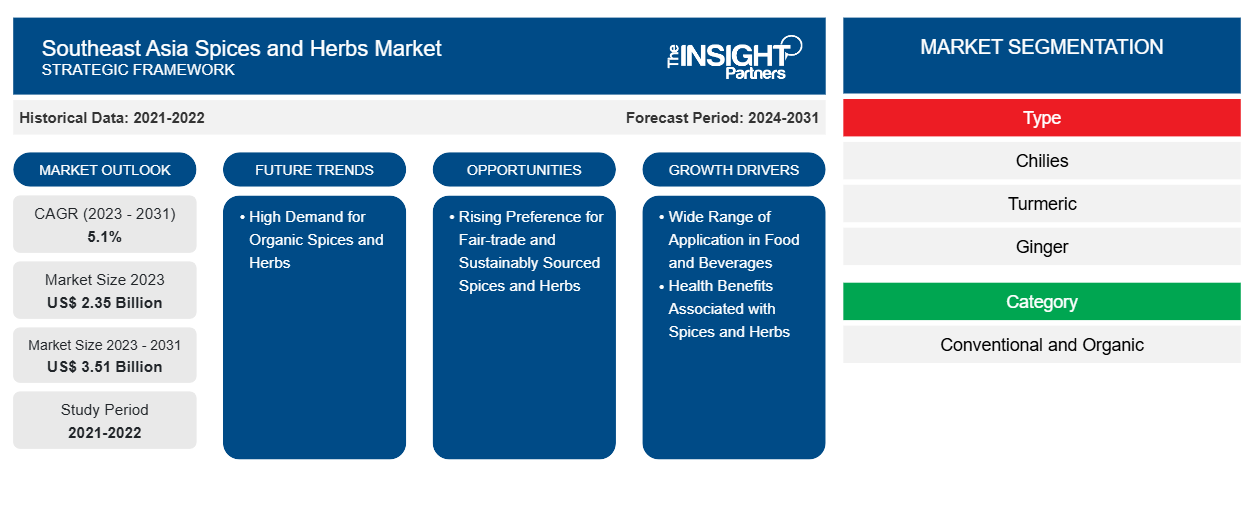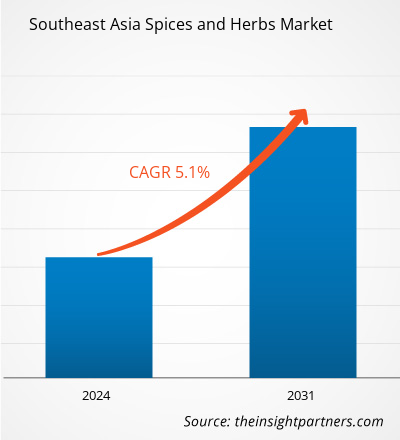The Southeast Asia spices and herbs market size is expected to reach US$ 3.51 billion by 2031 from US$ 2.35 billion in 2023; the market is estimated to register a CAGR of 5.1% from 2023 to 2031.
Market Insights and Analyst View:
Spices and herbs have been in use for centuries for both culinary and medicinal purposes. Spices not only enhance the flavor, aroma, and color of food and beverages, but they can also protect from acute and chronic diseases. Herbs and spices consist of various parts of plants cultivated for their aromatic, pungent, or otherwise desirable substances, including rhizomes, bulbs, barks, flower buds, stigmas, fruits, seeds, and leaves. Technically, herbs come from aromatic plants grown in the temperate zone, while spices are products of tropical plants. Both are used to flavor food and are rich in phytochemicals, which are healthful plant chemicals. Spices and herbs possess antioxidant, anti-inflammatory, antitumorigenic, anticarcinogenic, and glucose- and cholesterol-lowering activities, as well as properties that affect cognition and mood. They are also excellent sources of antioxidants with their high content. Additionally, herbs and spices have been widely valued for centuries for their healing properties and their flavor. Moreover, modern research has found numerous evidence for health benefits. The use of certain spices and herbs alone or in blends can replace or reduce salt and sugar in foods, contributing to their increased demand. All these factors are supporting the Southeast Asia spices and herbs market growth.
Growth Drivers and Challenges:
Spices and herbs are used in food seasoning to unveil tempting aromas and enhance the taste and flavor of food products. Herbs and spices can be used as alternatives for less desirable taste promoters, such as sugar, salt, and fat. Saffron is a major spice used as a flavoring and coloring agent in various food items and beverages.
Recently, spices and herbs have gained importance as potential sources of natural food preservatives due to the growing interest in natural preservatives, which have been better alternatives to chemical additives in the food processing industry. They help in delaying the natural process of spoilage by decreasing or eliminating foodborne pathogens, thus increasing the shelf life of the end product. Garlic, celery seeds, tarragon, dill, cinnamon, turmeric, and cumin all have compounds functioning as preservatives. Certain herbs also possess antimicrobial, antifungal, and insecticidal properties.
The antimicrobial properties of herbs and spices control the growth of pathogenic bacteria in dairy products, owing to which the dairy products are protected and their minimal shelf life gets extended subsequently. Apart from preventing microbial infestation, herbs and spices impart unique flavors to cheese—referred to as flavored cheese or specialty cheese.
Owing to their nutritional benefits and flavors, herbs and spices are also used to produce functional beverages and enhanced water that boost the immune system, increase vitality, and fight degenerative diseases.
Thus, a wide range of applications of spices and herbs in various food items and beverages aids in an upward trajectory of the Southeast Asia spices and herbs market.
Customize This Report To Suit Your Requirement
You will get customization on any report - free of charge - including parts of this report, or country-level analysis, Excel Data pack, as well as avail great offers and discounts for start-ups & universities
Southeast Asia Spices and Herbs Market: Strategic Insights

-
Get Top Key Market Trends of this report.This FREE sample will include data analysis, ranging from market trends to estimates and forecasts.
Report Segmentation and Scope:
The “Southeast Asia Spices and Herbs Market Analysis and Forecast to 2031” is a specialized and in-depth study with a significant focus on market trends and growth opportunities. The report aims to provide an overview of the market with detailed market segmentation by type, category, and end use. The market has witnessed high growth in the recent past and is expected to continue this trend during the forecast period. The report provides key statistics on the consumption of spices and herbs in Southeast Asia. In addition, the Southeast Asia spices and herbs market report provides a qualitative assessment of various factors affecting the market performance in Southeast Asia. The report also includes a comprehensive analysis of the leading players in the market and their key strategic developments. Several analyses on the market dynamics are also included to help identify the key driving factors, Southeast Asia spices and herbs market trends, and lucrative opportunities that would, in turn, aid in identifying the major revenue pockets.
The Southeast Asia spices and herbs market forecast is estimated on the basis of various secondary and primary research findings, such as key company publications, association data, and databases. Further, the ecosystem analysis and Porter's five forces analysis provide a 360-degree view of the market, which helps understand the entire supply chain and various factors affecting the market performance.
Segmental Analysis:
The Southeast Asia spices and herbs market is segmented on the basis of type, category, and end use. Based on type, the market is segmented into chilies, turmeric, ginger, garlic, cumin, oregano, basil, parsley, bay leaves, and others. Other types of spices and herbs are lemongrass, galangal, kaffir lime leaves, pandan leaves, black pepper, and cinnamon, among others. As global culinary trends evolve, there is a growing appreciation for diverse and exotic flavors, encouraging consumers to explore a wider variety of spices and herbs in their cooking. The increasing curiosity and openness to experimenting with new ingredients have increased the demand for spices and herbs beyond the traditional staples. Further, the growing awareness of antioxidant and anti-inflammatory properties in many spices and herbs has contributed to their demand as consumers seek flavorful additions to their meals that promote health benefits.
Based on category, the Southeast Asia spices and herbs market is segmented into organic and conventional. The conventional segment dominated the market, accounting for a larger Southeast Asia spices and herbs market share in 2023. Conventional spices and herbs are produced using traditional farming methods that may involve synthetic pesticides, fertilizers, and other agricultural chemicals. Conventional spices and herbs are often more affordable than their organic counterparts, making them accessible to a broader range of consumers. This contributes to their growing popularity among consumers seeking convenient, cost-effective food options. Overall, the demand for conventional spices and herbs is rising due to their convenience, affordability, and improved quality, meeting the needs of consumers with busy lifestyles.
Based on end use, the market is segmented into food processing, food retail, and food service. The food processing segment dominated the market, accounting for the largest Southeast Asia spices and herbs market share in 2023. The demand for spices and herbs in food processing in Southeast Asia is increasing due growing food & beverages industry and the increasing popularity of Southeast Asian flavors globally. Food manufacturers are incorporating diverse spices and herbs into processed food to cater to the global demand for authentic and flavorful products. In addition, spices and herbs are valued for their taste and natural preservative properties, which enhance the shelf life of processed foods without the need for artificial additives. As consumers become health-conscious, there is a growing preference for natural ingredients, which are perceived to offer health benefits and enhance the nutritional profile of processed food.
Regional Analysis:
Based on region, the market in Southeast Asia was valued at more than US$ 2,351.64 million in 2023. The upsurge in demand for whole spices and herbs in Southeast Asia can be attributed to the region's cultural exchange and culinary diversity. Southeast Asia is at the crossroads of cultures, influenced by various ethnic groups, migrations, and historical trade routes. The cultural exchange has enriched the region's culinary landscape, resulting in a vibrant fusion of flavors and ingredients. Spices and herbs give tantalizing flavors and aromas to various cuisines. As a result, there is a high demand for a wide variety of spices and herbs to recreate traditional dishes and experiment with new flavor combinations. The region's openness to international influences has also led to a growing interest in global cuisines, further driving the demand for diverse spices and herbs. Lemongrass, bird's eye chili peppers, galangal, Thai basil, kaffir lime leaves, torch ginger flower, Vietnamese mint leaves, coriander root, tamarind, pandan leaves, and curry leaves are among the common spices and herbs used in Southeast Asia.
Southeast Asia's cafe and casual dining market is experiencing an increase in the demand for spices and herbs due to a culinary renaissance emphasizing diverse and flavorful dishes. The region's growing preference for innovative cafe concepts, fusion cuisine, and vibrant dining experiences has propelled the need for various spices and herbs to enhance the flavors of dishes served in these establishments. Factors such as rapid urbanization, a rise in the middle-class population, and the influence of Western dining trends contribute to Southeast Asia's spices and herbs market growth. At the same time, the region's rich culinary heritage and the growing interest in food tourism propel the expansion of cafes and the preference for casual dining. Additionally, the increased visibility of Southeast Asian cuisine on social media and food tourism platforms attracts locals and tourists toward Southeast Asian dishes, stimulating the demand for authentic spices and herbs to replicate the region's unique flavors.
Competitive Landscape and Key Companies:
McCormick & Co. Inc., Molinos de la Especia Inc., Badia Spices, Inc., PT. Aroma Maharani Rempah, PT. Sari Bumbu Indonesia, Gyllmarc Ingredients Incorporated, PT. Terra Madia Selaras, PT. Supa Surya Niaga, Natraco Spices Indonesia, and East Java & Co are among the key players profiled in the Southeast Asia spices and herbs market report. The market players focus on providing high-quality products to fulfill customer demand.
Report ScopeSoutheast Asia Spices and Herbs Market Report Scope
| Report Attribute | Details |
|---|---|
| Market size in 2023 | US$ 2.35 Billion |
| Market Size by 2031 | US$ 3.51 Billion |
| CAGR (2023 - 2031) | 5.1% |
| Historical Data | 2021-2022 |
| Forecast period | 2024-2031 |
| Segments Covered |
By Type
|
| Regions and Countries Covered |
Southeast Asia
|
| Market leaders and key company profiles |
|
Southeast Asia Spices and Herbs Market Players Density: Understanding Its Impact on Business Dynamics
The Southeast Asia Spices and Herbs Market is growing rapidly, driven by increasing end-user demand due to factors such as evolving consumer preferences, technological advancements, and greater awareness of the product's benefits. As demand rises, businesses are expanding their offerings, innovating to meet consumer needs, and capitalizing on emerging trends, which further fuels market growth.

- Get the Southeast Asia Spices and Herbs Market top key players overview
- Historical Analysis (2 Years), Base Year, Forecast (7 Years) with CAGR
- PEST and SWOT Analysis
- Market Size Value / Volume - Regional, Country
- Industry and Competitive Landscape
- Excel Dataset
Recent Reports
Testimonials
Reason to Buy
- Informed Decision-Making
- Understanding Market Dynamics
- Competitive Analysis
- Identifying Emerging Markets
- Customer Insights
- Market Forecasts
- Risk Mitigation
- Boosting Operational Efficiency
- Strategic Planning
- Investment Justification
- Tracking Industry Innovations
- Aligning with Regulatory Trends





















 Get Free Sample For
Get Free Sample For